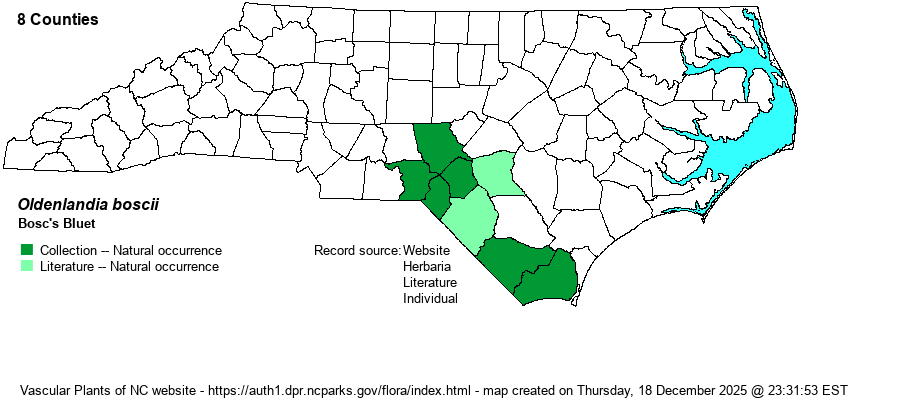| Author | (de Candolle) Chapman | |
| Distribution | Limited to the southwestern Coastal Plain, from Moore and Richmond counties southeast to Brunswick County. The Richmond County population was discovered in 2024 at Racetrack Pond on the Sandhills Game Land. In 2024 an adventive population was found by Alexander Krings at a turf farm in Pamlico County; suggesting that this species has the ability to reproduce outside its natural habitats.
This is a Southern species, ranging from southeastern VA and southern MO south to the FL Panhandle and central TX. Thus, this species could be found eventually in the central and northern Coastal Plain. | |
| Abundance | Very rare to rare, and sporadic in appearance, as it often is found in fluctuating waters of pools and Carolina bays. Though it is State Threatened, the NCNHP has a State Rank of S2. Their database has nine records, of which most are still extant, but the website editors feel that S1S2 is more accurate. | |
| Habitat | This is a wetland species of stationary waters. It grows in drawdown mud and shores of various lakes, ponds, and pools, in clay-based Carolina bays, and rarely along muddy shores of moving waters. It can disappear for several years if water levels are not appropriate. The Richmond County population occurred on the pond bottom during a prolonged drought in 2024. | |
| Phenology | Blooms from mid-July through September, and fruits shortly after flowering. | |
| Identification | This is a quite insignificant-looking species, often leaning or flattened by water into a procumbent position, with a slender stem and slender leaves, as well. It grows to about 8-10 inches tall or long, with a number of pairs of opposite leaves, each linear to elliptic, about 3/4-inch long, and barely 1/10-inch wide. The very small flowers grow in leaf axils, rather bell-shaped but with 4 tiny white petals. It is most similar to Edrastima uniflora, which was formerly named as O. uniflora. That species also grows in bays and pool margins, but it is quite villous to hispid all over. Also, its leaves are somewhat ovate, about 2 times longer than wide. Weakley (2018) reminds readers that, in vegetative condition, it resembles the unrelated Polypremum procumbens, which normally grows away from water and wetlands, though it could in some situations. Few biologists seem to be familiar with O. boscii, as it is rare, and as it is easy to overlook owing to its wispy look and tiny axillary flowers. | |
| Taxonomic Comments | None
| |
| Other Common Name(s) | Bosc's Mille-graines | |
| State Rank | S2 [S1S2] | |
| Global Rank | G5 | |
| State Status | T | |
| US Status | | |
| USACE-agcp | FACW link |
| USACE-emp | FACW link |

